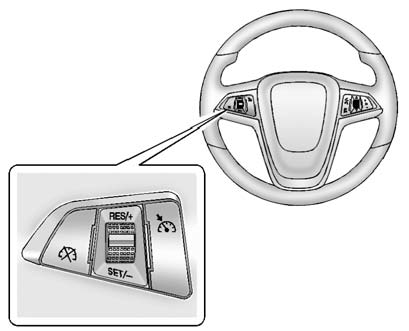Cruise Control
The cruise control lets the vehicle maintain a speed of about 40 km/h (25 mph) or more without keeping your foot on the accelerator. Cruise control does not work at speeds below 40 km/h (25 mph).
The vehicle has a Traction Control System (TCS) or StabiliTrak system that begins to limit wheel spin while using cruise control and the cruise control will automatically disengage. See Traction Control System (TCS) or StabiliTrak® System . When road conditions allow you to safely use it again, the cruise control can be turned back on.
![]() WARNING
WARNING
Cruise control can be dangerous where you cannot drive safely at a steady speed. So, do not use the cruise control on winding roads or in heavy traffic.
Cruise control can be dangerous on slippery roads. On such roads, fast changes in tire traction can cause excessive wheel slip, and you could lose control. Do not use cruise control on slippery roads.

 (On/Off): Press to turn the cruise
control system on and off. An indicator light will turn on or off in the instrument
cluster.
(On/Off): Press to turn the cruise
control system on and off. An indicator light will turn on or off in the instrument
cluster.
 (Cancel): Press to disengage cruise
control without erasing the set speed from memory.
(Cancel): Press to disengage cruise
control without erasing the set speed from memory.
RES/+ (Resume/Accel): Move the thumbwheel up to resume to a previously set speed or to accelerate.
SET/− (Set/Coast): Move the thumbwheel down to set a speed and activate cruise control or to make the vehicle decelerate.
See also:
Deleting Name Tags
The system uses the following commands to delete name tags:
► Delete
► Delete all name tags ...
Malfunction Indicator Lamp
A computer system called OBD II (On-Board Diagnostics-Second Generation) monitors
the operation of the vehicle to ensure emissions are at acceptable levels, to produce
a cleaner environment.
This ...
Languages
The vehicle supports English, French (Canadian), and Spanish. The default language
is English.
Turn the TUNE/MENU knob to highlight the language. Press TUNE/MENU to change
the display language. ...


